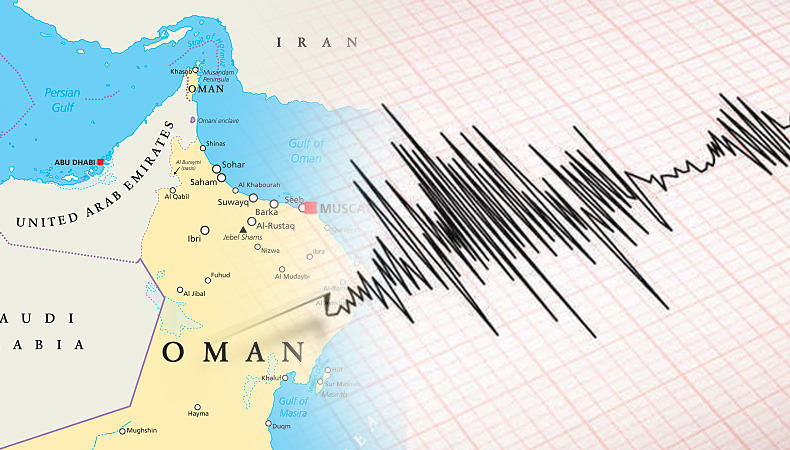6.1-magnitude earthquake hits off the coast of Oman

A magnitude 6.1 earthquake that struck the region off the coast of Oman left many locals and visitors stunned and uneasy. This natural occurrence, which had its epicenter in the Arabian Sea, has sparked debate over how it occurred and the extent of the damage it caused. This blog post will cover everything you need to know about the recent earthquake, from its causes to its aftershocks, as well as provide information on how people can get ready for earthquakes in the future. So fasten your seatbelts and get ready to learn everything there is to know about this potent natural force!
Where the earthquake occurred?
Off the coast of Oman, the most recent earthquake that shook the Arabian Sea had its epicenter. Tectonic plate movement beneath the earth’s surface causes frequent earthquakes and tremors that are characteristic of this region’s seismic activity.
The earthquake was felt at a depth of 10 kilometers, which is regarded as shallow geologically. How much damage an earthquake can produce depends on the epicenter’s location as well as its depth. People are more likely to experience shallow earthquakes, and they can also do more damage.
The Makran Subduction Zone, where two tectonic plates collide and meet under the sea bed, is another active fault line that runs through this region of the world. Strong earthquakes like this one are frequently the result of these collisions.
This earthquake serves as a reminder that seismic activity can happen anywhere at any time without prior notice even though it was far from any significant cities. It emphasizes how crucial it is to always be ready for these types of natural disasters, regardless of where you live or work.
Why did the earthquake happen?
Many people were curious about what caused the earthquake, which had a magnitude of 6.1 and occurred off the coast of Oman. The movement of tectonic plates, which make up the earth’s crust and uppermost mantle, is typically what causes earthquakes.
The Arabian plate, on which Oman is located, is currently advancing northward towards Eurasia at a rate of about 2 cm per year. When two plates collide along a fault line, the pressure that builds up there causes earthquakes to occur when the pressure is suddenly released.
Although the precise fault that caused this earthquake has not yet been found, experts think it may have happened along one of the area’s many minor faults. Given their proximity to densely populated areas like Muscat, these minor faults have the potential to cause large earthquakes.
Not all earthquakes are caused by tectonic activity; some can also be caused by human activity, like mining or drilling. But in this instance, it appears likely that underground natural forces were at play beneath Oman’s coastline.
What magnitude was the earthquake?
A strong earthquake with a magnitude of 6.1 struck off the coast of Oman, causing tremors to be felt in several neighboring nations. The Richter scale, which ranges from 0 to 10, is used to determine an earthquake’s strength.
A strong earthquake, defined as one with a magnitude of 6, has the potential to harm buildings and other structures. But it’s important to remember that different effects may result from earthquakes, depending on things like depth, location, and soil type.
This particular earthquake occurred about 10 kilometers below sea level, which may have increased its power. Since it happened close to tectonic plate boundaries, where seismic activity is more likely to occur, the location also had an impact.
Read | Netflix ‘Queen Cleopatra’ Depicts The Story Of An Ancient Egyptian Queen
Additionally, the type of rock that makes up the subsurface can influence how much an earthquake shakes. Seismic waves are more likely to be amplified by soft sedimentary rocks than by harder rock types like granite or basalt.
Although a magnitude 6.1 earthquake may not be thought of as particularly powerful in comparison to some previous earthquakes in history, it still had enough power to worry and make people in the affected areas more aware of earthquake safety precautions.
What harm has been done so far?
Fortunately, no fatalities have been reported as of yet in the magnitude 6.1 earthquake that occurred off the coast of Oman. Residents rushed out of their homes and buildings out of fear as the tremor was felt in many areas, including Muscat and Dubai.
According to local media outlets, the quake only slightly damaged the infrastructure and buildings in the affected areas. According to reports, landslides brought on by the earthquake also damaged some roads.
The Omani government has urged citizens to maintain their composure and heed safety warnings in the event of such incidents. Emergency response teams are ready to respond to any new developments or emergencies.
People who live in seismic regions, such as Oman, must take the appropriate safety measures when an earthquake occurs. Finding safe areas in your home or workplace where you can hide during such incidents is a good idea. You should also keep a supply of emergency supplies like food, water, and first-aid kits on hand.
Being ready in advance can help reduce potential earthquake damage and ensure your safety as well as the safety of those around you.
Do you notice any aftershocks?
There is always a possibility of aftershocks following an earthquake. Aftershocks, which are smaller earthquakes that follow the primary quake and can last for days or even weeks, are common. There may have been several aftershocks in the area following the recent magnitude 6.1 earthquakes off the coast of Oman.
Aftershocks typically happen as a result of the mainshock’s faults releasing built-up stress, which results in more shaking. Even though these subsequent tremors are frequently weaker than their predecessors, they can still be strong enough to cause damage if they strike places that have already been damaged by the primary quake.
It’s crucial for people living in affected areas to always be alert and prepared because these aftershocks can occur without prior notice and aren’t always predictable. They should keep an eye on local authorities’ emergency alerts and news reports, and be prepared to flee right away if necessary.
People should make sure their homes are structurally sound and secure any loose items that could become projectiles during shaking to be ready for potential aftershocks. A close-by emergency kit stocked with items like water, non-perishable food, first aid supplies, flashlights, batteries, and radio is also imperative.
Although aftershocks may initially seem frightening, it is important to maintain composure and adhere to safety procedures until everything has completely subsided.
What can be done to get ready for earthquakes?
Earthquakes can occur anytime, anywhere, and are unpredictable. However, there are precautions people can take to get ready and lessen earthquake damage.
The creation of an emergency plan with your family or roommates is one of the most crucial things. A designated meeting location, a contact person outside the affected area who everyone agrees to check in with after an earthquake, and instructions for what to do while an earthquake is occurring should all be part of this plan.
Additionally, it’s crucial to have emergency supplies on hand, including food, water, first aid kits, flashlights with extra batteries, and blankets. You can stay safe using these materials while waiting for assistance.
The ability to turn off gas valves in your home and make sure that heavy objects are secured so they don’t fall during shaking are also essential skills.
We can avoid injuries or save lives by being ready before an earthquake strikes. When it comes to natural disasters like earthquakes, it is always better to be safe than sorry.




